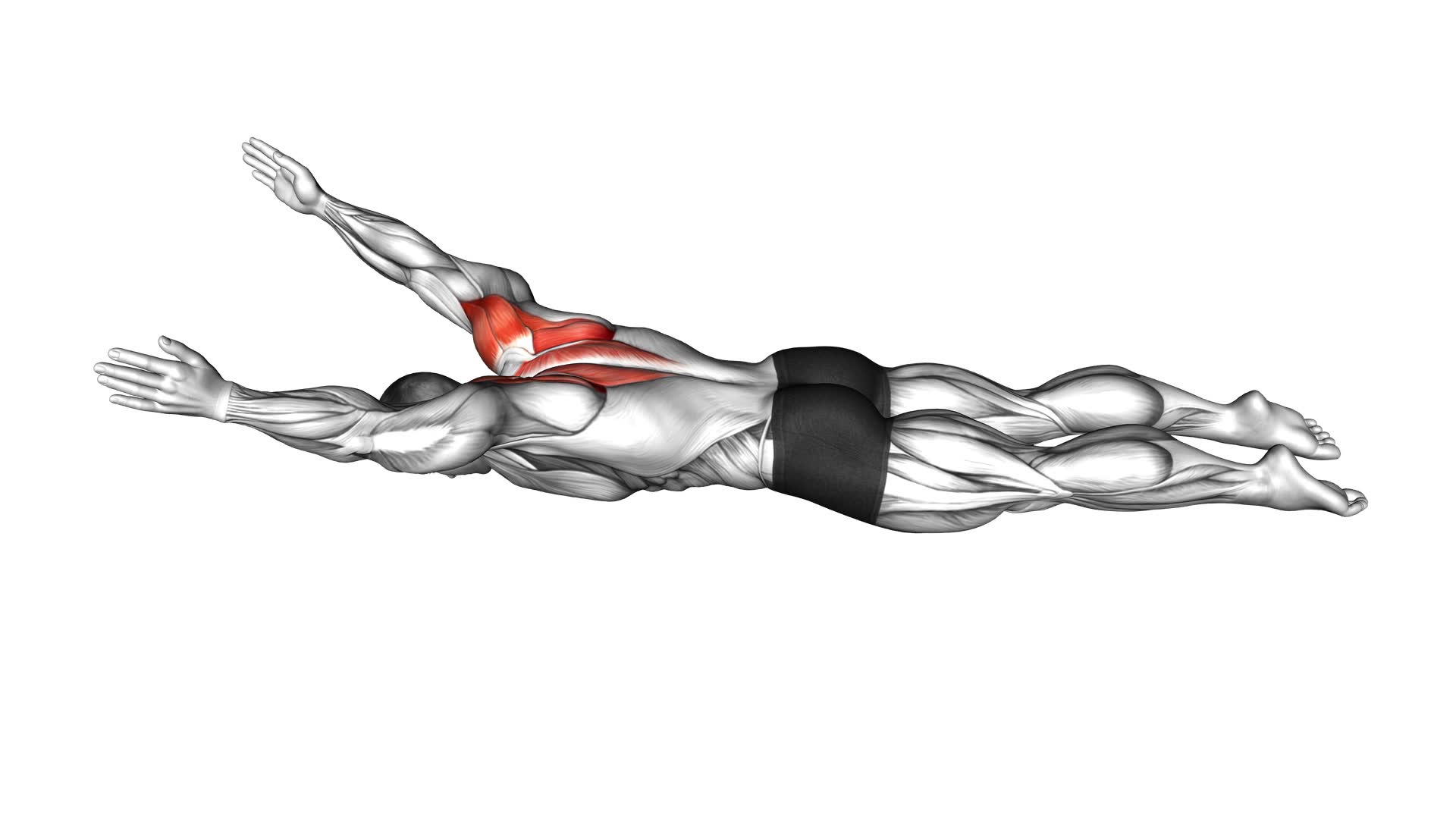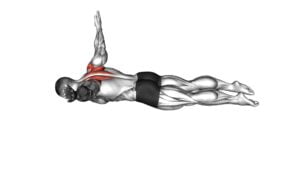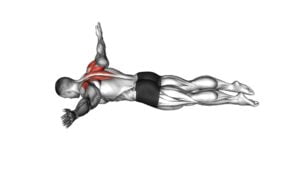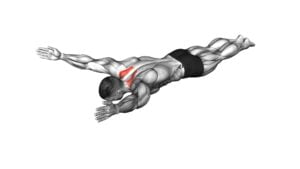Lying Prone W to Y – Video Exercise Guide & Tips

Looking to strengthen your upper back and shoulders? Check out our video exercise guide on Lying Prone W to Y. This exercise targets key muscles and improves posture.
Watch This Exercise Video
Learn the proper technique, variations, and common mistakes to avoid. Plus, we've got tips to help you get the most out of your workout.
Get ready to feel the burn and achieve better posture with this effective exercise. Watch the video and start reaping the benefits today!
Key Takeaways
- Lying Prone W to Y exercise activates multiple muscles in the upper body.
- It improves posture and shoulder stability.
- The exercise enhances overall upper body strength.
- The exercise targets back muscles (rhomboids and lower trapezius) and shoulder muscles (deltoids, rotator cuff, and scapular stabilizers).
Benefits of Lying Prone W to Y Exercise
There are five key benefits you can gain from performing the lying prone W to Y exercise. This exercise is known for its ability to activate multiple muscles in your upper body. During the exercise, you engage your back muscles, including the rhomboids and lower trapezius, which help improve posture and shoulder stability. Additionally, the prone W to Y exercise targets your shoulder muscles, including the deltoids, rotator cuff, and scapular stabilizers. By activating these muscles, you can enhance your overall upper body strength and improve your ability to perform daily activities.
Another important benefit of the lying prone W to Y exercise is injury prevention. By strengthening the muscles in your back and shoulders, you can reduce the risk of injuries, such as shoulder impingement or rotator cuff tears. This exercise helps to stabilize your shoulder joint, improving its mobility and reducing the likelihood of overuse injuries.
In summary, the lying prone W to Y exercise offers multiple benefits, including muscle activation in the upper body and injury prevention. By incorporating this exercise into your routine, you can strengthen key muscles and improve your overall upper body strength.
Next, let's explore the proper technique for performing the lying prone W to Y exercise.
Proper Technique for Lying Prone W to Y
To perform the lying prone W to Y exercise properly, you need to follow the correct technique and form. This exercise is beneficial for back pain relief and can be modified to suit your fitness level. Here's how to do it:
- Lie facedown on a mat with your arms extended in front of you.
- Lift your chest off the ground while squeezing your shoulder blades together, forming a W shape with your arms.
- Slowly extend your arms out to the sides, forming a Y shape, while keeping your chest lifted.
- Hold the Y position for a few seconds, then return to the starting position and repeat.
By following these steps, you engage and strengthen the muscles in your upper back and shoulders, improving posture and reducing back pain. It's important to maintain proper form throughout the exercise to maximize its benefits and prevent injury.
Now that you know the proper technique for the lying prone W to Y exercise, let's explore variations and progressions to challenge yourself further and continue improving your back strength and flexibility.
Variation and Progressions for Lying Prone W to Y
To progress the lying prone W to Y exercise, try incorporating resistance bands to increase the challenge and build additional strength in your upper back and shoulders. Resistance bands are a versatile tool that can be used to modify the exercise and create advanced variations.
One way to incorporate resistance bands is by attaching them to a stable anchor point and looping them around your wrists. This will add resistance to the movement, making it more challenging to lift your arms into the W and Y positions. Start with a light resistance band and gradually increase the tension as you get stronger.
Another variation is to use a thicker resistance band or multiple bands to increase the resistance. This will require more effort from your muscles to perform the exercise and further enhance your strength gains.
If you find it difficult to perform the lying prone W to Y exercise on the floor, you can also try doing it on an exercise ball. This will add an element of instability, engaging your core muscles even more.
Remember to always maintain proper form and control throughout the exercise. If you experience any pain or discomfort, modify the exercise or consult a fitness professional for guidance. With consistent practice and gradual progression, you'll continue to challenge your upper back and shoulder muscles, leading to improved strength and posture.
Common Mistakes to Avoid During Lying Prone W to Y
To avoid common mistakes during the lying prone W to Y exercise, always remember to perform it with proper form and control. This will help maximize the benefits of the exercise and reduce the risk of injury. Here are some common mistakes to avoid:
- Raising your shoulders: Keep your shoulders relaxed throughout the exercise. Raising them can cause tension in the neck and upper back, compromising the effectiveness of the exercise.
- Lifting your legs too high: When performing the W to Y movement, it's important to maintain control and not lift your legs too high. Lifting them beyond a comfortable range can strain the lower back and increase the risk of injury.
- Arching your lower back: Maintain a neutral spine position throughout the exercise. Avoid arching your lower back, as this can lead to lower back pain and discomfort.
Tips for Getting the Most Out of Lying Prone W to Y
To maximize the effectiveness of the lying prone W to Y exercise and get the most out of it, focus on these tips.
Firstly, pay attention to your posture. While performing the exercise, make sure to keep your back straight and aligned with your neck and hips. This will help in improving your posture over time.
Secondly, engage your back muscles throughout the movement. As you lift your arms off the ground, consciously activate the muscles in your upper and middle back. This will help in strengthening those muscles and improving your overall back strength.
Next, avoid excessive arching of your lower back. While it's important to engage your back muscles, be careful not to overextend your lower back, as this can lead to strain or injury. Keep your core engaged and maintain a neutral spine position throughout the exercise.
Additionally, focus on the quality of the movement rather than the quantity. It's better to perform fewer reps with proper form than to rush through the exercise with poor technique. Take your time and perform each repetition with control and precision.
Finally, listen to your body and adjust the exercise as needed. If you experience any pain or discomfort, modify the range of motion or decrease the resistance. It's important to work within your own limits and gradually increase the difficulty as you get stronger.
Frequently Asked Questions
How Many Repetitions Should I Do When Performing the Lying Prone W to Y Exercise?
When performing the lying prone W to Y exercise, it's important to focus on the repetition range and maintaining proper form.
The repetition range can vary depending on your fitness level and goals. It's recommended to start with a lower number of repetitions, such as 8-10, and gradually increase as you get stronger.
Remember to keep your core engaged, shoulders down, and perform the movements in a controlled manner to maximize the benefits of this exercise.
Can I Perform the Lying Prone W to Y Exercise if I Have a Lower Back Injury?
If you have a lower back injury, it's important to be cautious when performing the lying prone W to Y exercise. This exercise can put strain on your lower back, so it may not be suitable for you.
It's best to consult with a healthcare professional or a certified trainer for modifications or alternative exercises that are safe and effective for your condition. Your safety and well-being should always be a priority.
Is It Normal to Feel Tension or Discomfort in My Shoulders While Doing the Lying Prone W to Y Exercise?
Feeling tension or discomfort in your shoulders while doing the lying prone W to Y exercise isn't uncommon. This exercise is designed to strengthen your shoulders, so some level of discomfort may be expected.
However, it's important to ensure that you're performing the exercise with proper form to minimize any unnecessary strain on your shoulders. Focus on maintaining a stable core and engaging your shoulder muscles throughout the movement.
If the discomfort persists or worsens, it's advisable to consult a healthcare professional.
Can I Use Weights While Performing the Lying Prone W to Y Exercise for Added Resistance?
Yes, you can use weights while performing the lying prone w to y exercise for added resistance. Incorporating weights can provide several benefits, such as increasing muscle strength and endurance in your shoulder muscles.
By adding resistance, you're challenging your muscles to work harder, which can lead to greater improvements in shoulder stability and overall upper body strength.
Just make sure to start with lighter weights and gradually increase the resistance as you get stronger.
How Often Should I Include the Lying Prone W to Y Exercise in My Workout Routine for Optimal Results?
To get optimal results, it's important to include the lying prone w to y exercise in your workout routine regularly. This exercise targets your upper back and shoulders, improving posture and strength.
Aim to do this exercise 2-3 times per week for maximum benefits. By incorporating the lying prone w to y exercise into your routine, you'll be able to see improvements in your upper body strength and overall fitness level.
Conclusion
In conclusion, the lying prone W to Y exercise is a beneficial exercise that targets the muscles in the upper back and shoulders.
By following the proper technique and incorporating variations and progressions, you can maximize the effectiveness of this exercise.
Avoid common mistakes such as arching the back or lifting the head too high.
Remember to engage your core and breathe properly throughout the exercise.
With these tips, you can get the most out of your lying prone W to Y workout.

Author
Years ago, the spark of my life’s passion ignited in my mind the moment I stepped into the local gym for the first time. The inaugural bead of perspiration, the initial endeavor, the very first surge of endorphins, and a sense of pride that washed over me post-workout marked the beginning of my deep-seated interest in strength sports, fitness, and sports nutrition. This very curiosity blossomed rapidly into a profound fascination, propelling me to earn a Master’s degree in Physical Education from the Academy of Physical Education in Krakow, followed by a Sports Manager diploma from the Jagiellonian University. My journey of growth led me to gain more specialized qualifications, such as being a certified personal trainer with a focus on sports dietetics, a lifeguard, and an instructor for wellness and corrective gymnastics. Theoretical knowledge paired seamlessly with practical experience, reinforcing my belief that the transformation of individuals under my guidance was also a reflection of my personal growth. This belief holds true even today. Each day, I strive to push the boundaries and explore new realms. These realms gently elevate me to greater heights. The unique combination of passion for my field and the continuous quest for growth fuels my drive to break new ground.







